Archive for the 'good advice' Category
Fungophobia
Monday, November 12th, 2007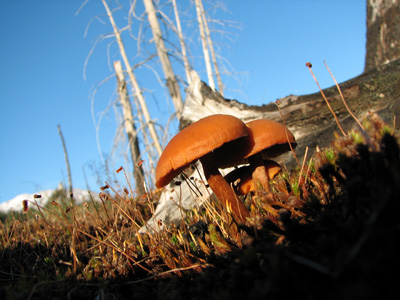
We found an abundant crop of these little brown mushrooms in Washington last week. I have no idea what they are, but I know what they’re not. Don’t worry we didn’t eat them. There are only a few dangerous mushrooms in our area and one of them is small and brown like this. The Deadly Galerina (Galerina autumnalis) is similar to one pictured above, but that doesn’t matter because you are unlikely to be collecting anything even remotely like it. Like most collectors, I usually don’t bother to collect or identify small mushrooms that I don’t plan to eat anyway unless they are exceptionally beautiful.
There are only two species which are likely to be an issue. Pholioto mutabilis is not a popular edible in part because it looks a lot like the Deadly Galerina and other mildly poisonous LMBs. More importantly it lacks a reputation as a choice edible so it will only attract the true hard core enthusiasts who want to try everything. These enthusiast are, by their very nature, knowledgeable enough to do so safely.
The mildly hallucinogenic Psilocybe stuntzii attracts more attention than P. mutabilis for obvious reasons. I don’t have any experience with it, but it is widely reported to have been found side by side with G. autumnalis. That sounds like a high risk high, but they are easily distinguished by the color of the spores. If you choose to collected Psilocybe stuntzii make a spore print of every mushroom and discard any that fail to print (and, of course, those that have cinnamon brown prints).
Some people have asserted that you could mistake a Deadly Galerina for a Candy Cap (Lactarius fragilis). However, the Lactarius genus is one the easiest genuses to identify and L. fragilis does not grow on wood. In reality, you’d have to be particularly dense to make this mistake and I have never heard of a case.
The Italian tradition has it that any mushroom growing on wood is safe and good to eat. This might be true in Italy, but not in North America. G. autumnalis being an obvious counter example.
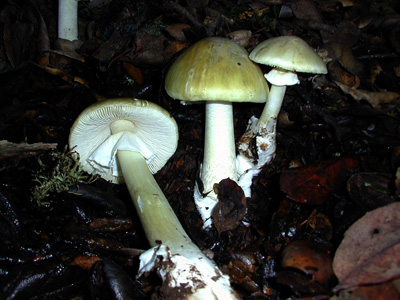
Amanita phalloides. Santa Cruz Mountains, California 2002
Amanita phalloides (Death Cap) causes more poisonings and deaths than any other mushroom found in North America. It is very distinct and incredibly common in California. The deadliness of this mushroom has nothing to do with amateur mushroom hunters confusing it with an edible species. The problem stems from Volvariella volvacea (Paddy-straw mushroom), a similar looking edible commonly collected in Cambodia, Laos, and Vietnam. It seems like every year or two a southeast asian immigrant family poisons themselves when they discover what they think are Paddy-straw mushrooms from home. Unfortunately, it often kills half the family. In 2004, I noticed that state and local parks around the bay area began putting up signs translated in to all the southeast asian languages warning people about the Death Cap.
Interestingly A. phalloides is not native to North America. It was probably brought in with soil attached to the roots of trees imported from Europe (norway spruce and cork).
The admonishment against collecting button stage mushrooms originates with Amanita ocreata (Destroying angel) and it’s close relatives. Prized edibles like Amanita calyptrata (Coccora) and Amanita velosa (Springtime amanita) can be difficult to distinguish form A. ocreata in the button stage. However, better advice would be: Learn to identify the genus Amanita before attempting to collect and eat any mushroom with gills. Then don’t consider eating any Amanita until until you have sufficient experience to identify all the most common Amanitas on sight.
I don’t have a good picture of a destroying angel. However, it is easy to recognize because it is pure white. Do not eat any pure white amanita.
The scary part:

All of the poisonous mushrooms mentioned contain the same poisons known as amatoxins. The mortality rate is about 50% and either way it is extremely unpleasant. Symptoms don’t start until it’s too late for standard poison remedies like induced vomiting or a stomach pump. There is no antidote but massive injections of penicillin might help. The only “cure” is a liver transplant.
Cases usually progress like this: Within a few hours the toxins start causing irreparable liver and kidney damage asymptomatically. Within 10-24 hours you start to get flu like symptoms including violent vomiting, diarrhea, and abdominal cramping. These are so severe that you might check yourself into a hospital even if you don’t suspect the mushrooms. After a couple days you start to recover. You feel better and the doctor lets you go home from the hospital. Another day later you relapse. Your liver fails and you go into a coma or die. Even if you survive it is unlikely that you will recover full health.
Wind Vane
Monday, September 3rd, 2007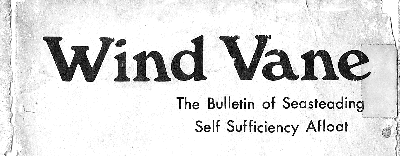
We found these old issues of Wind Vane; an early zine about multihulls, cruising, and seasteading from some of the founders of the movement. Contributing authors include Jim Brown, Jo Anna Brown, Tom Freeman, Jo Hudson, Tim Mann, and John Marples. It makes interesting reading. I don’t know how many issues were published but if you have some that I’m missing please send them to us and we’ll post them along with these.
Wind Vane Volume 1 Number 1, 1976 (9.0 MB)
Wind Vane Volume 1 Number 2, 1976 (8.9 MB)
Wind Vane Volume 2 Number 1, 1977 (5.8 MB)
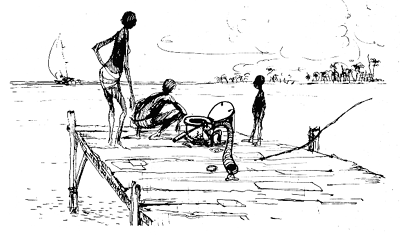
Advice from Gia
Tuesday, February 6th, 2007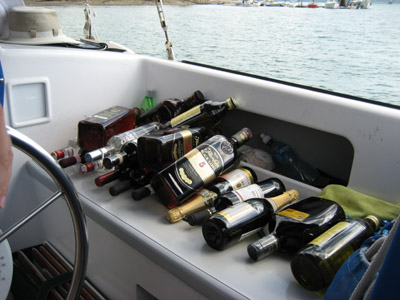
Golfito, Costa Rica.
“There are a lot of drinking hours between here and Panama City.”
Concerning Nutella
Monday, February 20th, 2006The best way to cut down on your Nutella intake is to first, finish off all the Nutella you have on your boat.


